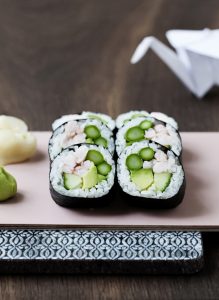
Well, both nigiri sushi and the large futomaki sushi rolls are popular among the Japanese. When it comes to take-away, many choose sushi rolls. However, it is not just any sushi roll.
There are many people who buy the large futomaki rolls. In the large rolls, there is room for several different types of filling. With just a few futomaki rolls you embrace the entire food pyramid.
Due to the size of the pieces, they are also easy to transport, they do not tip over so easily.
Nirigi sushi is very popular among the Japanese who are interested in eating several different fish during a meal.
Most often, nigiri sushi boxes are sold with 8 pieces of sushi.
3 of the pieces will be with 3 different kinds of fish. One will be with squid.
The last 2 will most often be vegetarian; it can be Japanese omelet and tofu.
A mixed Japanese nigiri box ensures that proteins come from several different sources without compromising on the healthy fish oil.
On the Sushi Course for Beginners, you learn step by step how to make tasty sushi that can be enjoyed on a daily basis and on special occasions.
_
Zoë has lectured and held sushi courses for A. P. Moller – Maersk, Hugo Boss Nordic, Novo Nordisk, Novartis, Velux, Gorrissen Federspiel, Beierholm revision, Elbek & Vejrup and many more.




